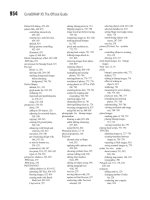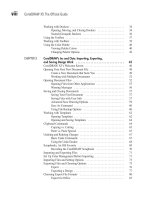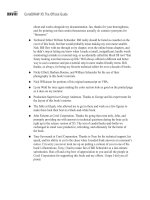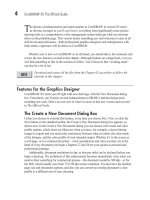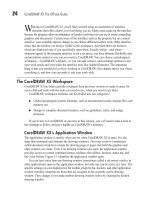CorelDRAW X5 The Official Guide part 4 potx
Bạn đang xem bản rút gọn của tài liệu. Xem và tải ngay bản đầy đủ của tài liệu tại đây (175.72 KB, 10 trang )
about and works alongside my documentation. Jan, thanks for your thoroughness,
and for pointing out that certain thesauruses actually do contain
synonyms for
“thesaurus.”
●
Technical Editor William Schneider. Bill really should be listed as coauthor on the
cover of this book, but that would probably mean making my own name smaller.
Nah. Bill flew with me through every chapter, even the online bonus chapters, and
he didn’t stop at letting me know when I made a (small, insignificant, hardly worth
mentioning) mistake in a tutorial step, or accidentally called the Mesh fill tool “that
funny looking icon that messes up fills.” Bill always offered a different and better
way to cast a sentence and put a tutorial step in more reader-friendly terms. Bill,
thanks, as always, for being my favorite technical editor for over a decade of books.
●
Nicky Elliott, Barbara Bouton, and William Schneider for the use of their
photography in this book’s tutorials.
●
Nick Wilkinson for portions of his original manuscript on VBA.
●
Lyssa Wald for once again making the color section look as good on the printed page
as it does on my monitor.
● Production Supervisor George Anderson. Thanks to George and his expert team for
the layout of this book’s interior.
●
The folks at Glyph, who allowed me to get in there and work on a few figures to
make them look their best in a black-and-white book.
●
John Falsetto at Corel Corporation. Thanks for going that extra mile, John, and
promptly providing me with answers to technical questions during the beta cycle
right up to the release version of X5. The sort of candid backs-and-forths we
exchanged in email were productive, refreshing, and ultimately for the better of
the book.
●
Tony Severenuk at Corel Corporation. Thanks to Tony for his technical support, his
speed, and his ability to cut to the chase when I needed frank answers at a moment’s
notice. I’m sorry you never took me up on putting a cartoon of you in one of the
book’s illustrations, Tony; I had to make fun of Bill Schneider as a last-minute
substitution. Hats off and a big bow of appreciation to you and all the people at
Corel Corporation for supporting this book and my efforts. I hope I did you all
proud.
xxviii CorelDRAW X5 The Official Guide
INTRODUCTION
Bear with me as you read this book. Like any ongoing piece of literature, CorelDRAW X5
The Official Guide is a work in progress. Yes, the book is complete, but I wanted to
approach the documentation of a new version of DRAW a little differently—okay, a lot
differently—than did previous versions of this book. I’ve tried very hard to put a little of
myself into this book, so you know that someone real, who professes to know CorelDRAW
in certain ways better than you do, is communicating with you. Let’s get real: CorelDRAW
is large. The application has so many features that you might feel at times as well-oriented
as if you were visiting this planet from another planet and a taxi driver dropped you off in
the middle of Los Angeles. At 2
A.M.
So I want you to know I’m here for you; I want you to feel as though you own a Pocket
Author, who talks to you in PlainSpeak, who makes tutorial files not only relevant but also
interesting, and who as an artist provides you with what you need to accomplish a task instead
of a generic, “This is what you need,” or a presumptuous, “This is what we think you need.”
I’m going to ask you to think about what it is you want to do in CorelDRAW throughout the
chapters, because you’re probably a goal-oriented sort of fine artist or business professional.
Although we have some of the best documentation on these pages concerning where items are,
what tools do, and other structural definitions of CorelDRAW, knowing where a tool is, and
knowing the steps to create a logo your boss wanted last Tuesday are two entirely different
approaches to understanding. One is called “having a bunch of facts memorized” and the other
is called Wisdom.
You’ll see what I mean as you read through the chapters and work through the dozens of
tutorial examples and files. Read this book, but embrace what you learn. I’ve learned through
years of working in the field of graphics that when you understand a technique or a principle,
you own it. You take it everywhere you go, it’s part of your own personal craft, and you’re all
the richer as an artist when you digest the information you’re given and turn it into something
uniquely your own.
xxx CorelDRAW X5 The Official Guide
CorelDRAW X5 The Official Guide is divided into nine parts plus two online Bonus
Chapters and an online Quick Reference listing keyboard shortcuts that’ll speed up your
work in CorelDRAW.
Organization is key to explaining things, so the parts follow a progression, from a very
basic introduction to later chapters that delve into special effects, and with this edition,
we’ve added two complete chapters on Corel PHOTO-PAINT, because it’s an important
program you will use if you first understand how to edit bitmap images. If you’re the type
of reader who likes to begin at the beginning and make a linear voyage to finish with the
last chapter, you won’t be surprised. However, the chapters are structured and fairly
compartmentalized to address a specific topic; if you want fast solutions for specific areas
within CorelDRAW, you can also “pick and choose.” One of the wonderful things about
books is that you can skip ahead and rewind—and probably do it faster than using an online
search engine.
●
Part I starts you off with the new features in CorelDRAW X5, a must-read for users
who’ve made the upgrade. In particular, Chapter 1 is a tutorial-based jumpstart into
graphics productivity—you’ll create new stuff as you learn what’s new! Also in this
part, you’ll be guided through CorelDRAW options, thoroughly pore through the
menus and palettes (including CorelDRAW dockers), and you’ll learn how to set up
the workspace to make you feel right at home. New users are encouraged to set aside
some quality time for this part—you’ll save a lot of time later when you want to get
to the Fun Stuff.
●
Part II focuses on navigating and measuring the workspace and your document, and
how to size things up, from measuring objects to moving and rotating them. You’ll
also learn how to set up a multi-page document, create brochures and flyers, and
you’ll see that each page can be a unique size and orientation.
●
Part III gets you up and running with two of the most important tools used in
designing original artwork, the Pen tools and the Shape tool. You’ll also get a handle
on creating shapes by using various presets CorelDRAW has to offer. Once you have
your object created and edited to your liking, it’s only natural to make more of them;
this part shows you how to arrange, group, duplicate, clone, and perform other tasks
in your document to make laying out what you’ve created an inspired effort.
●
Part IV dives into typography, working with artistic and paragraph text, spelling and
other CorelDRAW proofing tools, and some special effects you can create for fancy
headlines. Sometimes it’s better to just say it instead of show it; CorelDRAW has the
ideal tools for both the text and graphic message, and these parts of the book also
show how to blend the two vehicles artistically for what you want to communicate.
Introduction xxxi
●
Part V puts the meat on the bones of the objects you design; in these chapters,
you’ll learn everything you need to know about object fills, outline properties, and
most importantly, about digital color. Learn how to define and apply uniform fills,
bitmap fills, and colors from different color models to your work so they’ll print
exactly as you intend them to. And if you need a map or schematic drawing, check
out this part for the lowdown on creating dashed lines, lines with arrowheads, and
more.
●
Part VI is a truly special part; you’ll see that 3D object and scene creation doesn’t
require a megabuck modeling program—you’ll find what you need to make scenes
in camera-perfect perspective with CorelDRAW’s Effects menu. You’ll also learn
how to extrude objects, letting CorelDRAW perform calculations to create a side
view of the front of objects you draw. It’s fun and the result can have the visual
impact you need to create new worlds and sell your ideas.
●
Part VII comes with a boatload of CorelDRAW special effects features, and these
chapters take you through the steps to distorting, blending, and creating photorealistic
effects such as object transparency and soft, lifelike shadows. If you’ve ever been
stuck at a point where your design needs that “special something,” look into this
special part of the book. Learn how to create shading like you’ve seen in airbrush
illustrations, to design chrome and glass-like objects, and to create a seamless
integration between what you draw and the digital photos you can place in your
document.
●
Part VIII (that’s “8” if you’re tired of reading Roman numerals) moves from vector
drawing to bitmap editing; specifically, you’ll learn how Corel PHOTO-PAINT can
help you resize and retouch photos and help you make near-perfect pictures into
outstanding ones. Also in this part, you’ll see how to work between DRAW and
PHOTO-PAINT, to make a seamless composition that contains both vector and
bitmap art. PHOTO-PAINT is part of the CorelDRAW Graphics Suite; it’s sitting
there for you on disk or on your hard drive. If you have a brochure or gallery photo
you need to get out there and get noticed, you need to get with the program, and the
program is Corel PHOTO-PAINT. This is truly an advanced section of the book, but
it’s accessible to readers of all skill levels, and its contents take you through working
with photographs, getting your prints looking their best, and more. You’ll also see
how to get the best look out of imported bitmaps, beginning right with CorelDRAW’s
Raw Lab. Learn how to work with image resolutions, and see how to export your
vector drawings to bitmap file format. You’ll also want to pore through CorelDRAW’s
HTML publishing features—make that print ad you’ve designed into a web banner
with only a few clicks. Finally…
●
Part IX (pronounced “icks”) introduces you to CorelDRAW’s extensive host of
print options and features; the techniques for output to paper, film, and transfer
materials; and CorelDRAW’s preflight options so your time and the expense of
professional printing are on your side. Also, you’ll learn how to prep your designs
for nonprinting purposes. Get all the details on how CorelDRAW X5 can export
your work for the Web, how to make a basic web page, and something additional
and quite special. On the CorelDRAW installation DVD is a full working copy of
SWiSH miniMax. This program can generate Flash animation for the Web; you’ll
learn step-by-step how to move copies of your CorelDRAW work to SWiSH,
animate the objects, add a little audio that’s provided for you via our website
download, and how about this: you’ll make a full-screen animation that loops (plays
over and over) that’s only 70K! A movie that’s smaller than some CorelDRAW files?
Yes. And it’s all laid out for you in terms that someone who has no previous
experience with animation can follow.
●
Online Bonus Chapters document Visual Basic for Applications (VBA) in a PDF
file you can download from www.mhprofessional.com/computingdownload and
www.theboutons.com. See how to write simple scripts without actually writing a
line of code (it’s visual; you record cursor movements), and speed up your work by
making common tasks automated through VBA. Also, learn how to design a
typeface using CorelDRAW, and export your very own TrueType font. Imagine
making and distributing a font that has your company logo to everyone in your
department. You’ll learn the steps in this online PDF document, and become font
savvy in a jiffy.
●
The CorelDRAW Quick Reference, which you’ll also find online, is full of
shortcuts you can use in CorelDRAW. Find a task you need to perform faster, and
the Quick Reference lists the combinations of keys you can press to get you where
you need to go.
Tutorial and Bonus Content: Where to Find It
You can’t miss a Tutorial section: it’s marked with the Educated Lightbulb icon. Many of
these Tutorials will go better and more smoothly, and better demonstrate a technique or
principle, if you have a working file loaded in the drawing window, so we’ve provided you
with several. To get the tutorial files, go to the following URLs:
●
www.mhprofessional.com From this page, click the Downloads link and locate
this book’s title to get to the tutorial files.
●
www.theboutons.com This is a mirror site for the files. Go to the top page, and
you can’t miss the conspicuous, obnoxious, but superbly designed CorelDRAW X5
Official Guide Download icon.
xxxii CorelDRAW X5 The Official Guide
Additionally, www.theboutons.com has some Bonus Content, goodies for our readers
that have nothing to do with this book’s Tutorials, but everything to do with your continuing
adventures in CorelDRAW. The Boutons are offering original, seamless tiling textures—
perfect for web page backgrounds, custom object fills, and backgrounds in your CorelDRAW
documents. You’ll also find high-resolution images of indoor and outdoor scenes with blank
signage. Because so many CorelDRAW users create billboards, package designs, and vinyl
signs for vehicles, we thought it would be nice if you could previsualize a logo or other signage.
You can then show your design to clients and coworkers before you go through the expense
of commercial printing.
The Boutons also offer original typefaces and some content that we want to remain a
surprise for now.
I know I speak for the entire group who helped make this book happen that we were
highly motivated to make this Official Guide reflect all the creative possibilities that you’ll
have fun learning, exploring, and building upon. Playtime isn’t the only time when a creative
person can have fun. Work time can be fun, too. It’s how you approach it.
So enough with introductions! Turn the page and get to the Good Stuff!
—Gary David Bouton
Introduction xxxiii
This page intentionally left blank
PART I
CorelDRAW X5
Essentials
This page intentionally left blank
CHAPTER 1
What’s New in
CorelDRAW X5?
3
